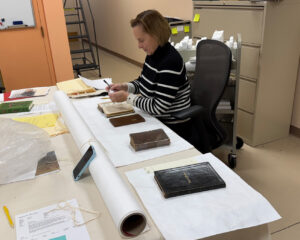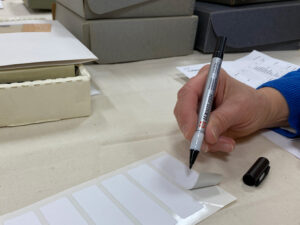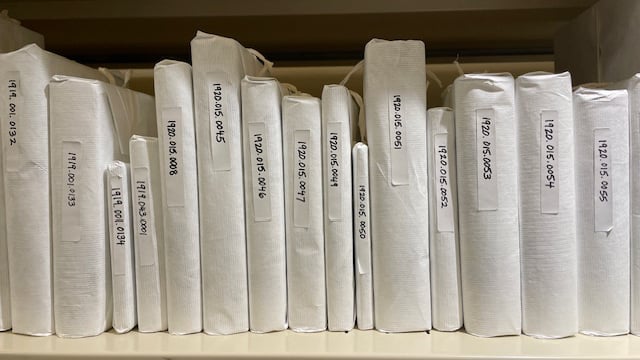What do conserving archival documents and weatherproofing new construction have in common?
They both make use of a flexible material that’s water repellent, breathable, and mold and mildew resistant. . . . Does that sound familiar?
If you guessed Tyvek®, you’re right!
And that’s what Longyear’s Collections team has been using in recent years, in line with evolving conservation practices that have moved away from paper-based wrappings to protect and preserve fragile historic documents. Of course, they’re not using the same Tyvek that’s wrapped around a building! The archival version that Longyear and other museums use is completely acid-free, without the anti-static coating found on construction-grade Tyvek. It also differs in weight and thickness.

Just a few weeks ago, Collections Senior Manager Sarah Sampson got to work with a large roll of this special material to safeguard Longyear’s “Baker Family Books” collection, ensuring their preservation in current form for decades to come. The Museum owns more than 60 volumes, mainly school texts and religious works from Mary Baker Eddy’s childhood homes in Bow and Sanbornton, New Hampshire, that offer a window into her early family life. The selection includes a leather-bound Geography Made Easy, a hardcover The Scholar’s Arithmetic, The Works of Virgil (volumes I and II), a French-language Vie de Washington, a collection of Shelley’s poems, and several copies of the Holy Bible and Book of Common Prayer.
Their well-thumbed pages, worn spines, and little notes, inscriptions, and signatures of the various Baker children on the flyleaves indicate that these books were put to good use and passed down from older to younger siblings over the years.1 Many of the books are signed by Mrs. Eddy’s brothers—Albert, Samuel, and George—who all attended the local district school in Bow, along with their sisters Abigail, Martha, and Mary. Most of the Baker children, including Mary, furthered their studies at private academies, which were common in the United States in the years before public high schools were established. Since Mary’s health was often frail, in addition to attending school when she was able, she also undertook some of her learning at home, with help from her parents and family members.2
While the books in this collection were in common use in the 19th century and are available digitally and in hard copy even today, what makes them special, Sarah says, is “their provenance, the fact that they were owned and used by all members of the Baker family.” Most of these items were acquired by Longyear Museum founder Mary Beecher Longyear in 1919, 1920, and 1925.

Over an intensive five hours working in the Museum’s climate-controlled basement and storage vaults, Sarah got 53 books neatly wrapped, tied just so (with archival cotton twill), and labeled using special acid-free paper and ink. (That’s a pretty speedy 5.66 minutes per book, for those of you who might be wondering!)
Even before she started wrapping these items, other Longyear colleagues had worked on a project to photograph and record each book—cover, inside title, table of contents—for entering into PastPerfect, an online collections management system used by Longyear (and other institutions such as the Boston Children’s Museum and National Trust for Historic Preservation in Washington, D.C.). This process will allow Longyear staff and researchers to reliably and quickly access information about this unique collection—which will continue to reside safely in Longyear’s climate-controlled vault (See photo at top of page.).
